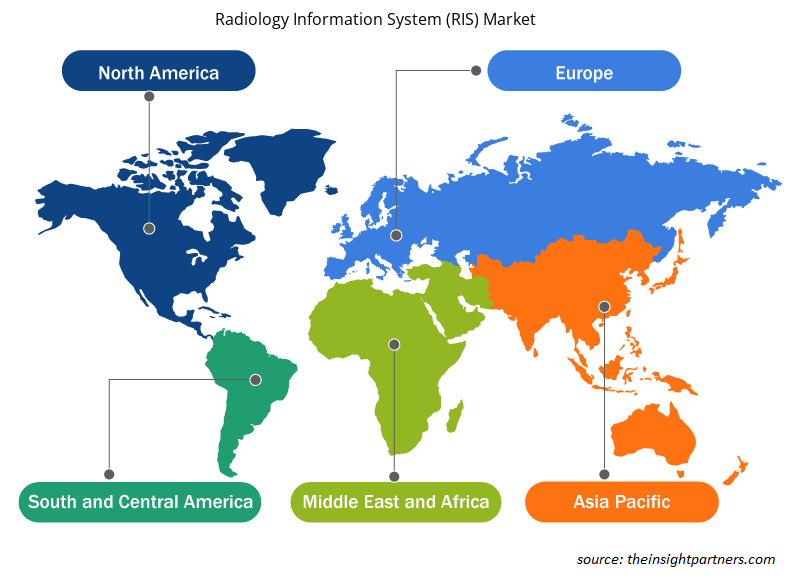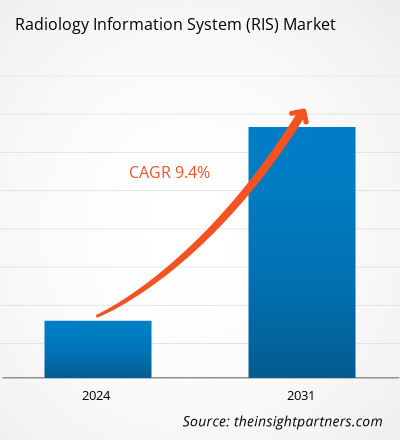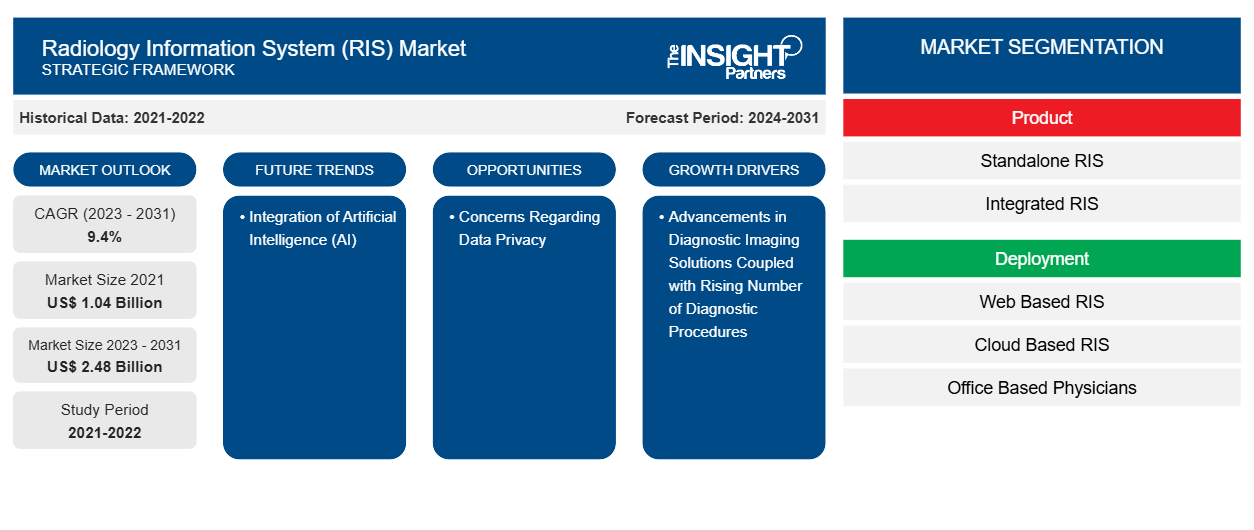2021년 방사선 정보 시스템(RIS) 시장 규모는 10억 4천만 달러였으며, 2023년 XX억 달러에서 2031년까지 24억 8천만 달러에 도달할 것으로 예상됩니다. 이 시장은 2023~2031년에 9.4%의 CAGR을 기록할 것으로 예상됩니다. 건강 위험이 적고 개발 지역에서 채택률이 높은 방사선 정보 시스템(RIS)에 대한 인식이 높아지면서 주요 방사선 정보 시스템(RIS) 시장 추세가 유지될 가능성이 높습니다.
방사선 정보 시스템(RIS) 시장 분석
주요 시장 성장 요인으로는 만성 질환 발병률 증가, 의료 정보 기술 시스템 접근성, 암 연구에 대한 정부 자금 지원 등이 있습니다. 나아가 만성 질환의 부담은 전 세계적으로 증가하고 있으며, 인구 고령화와 더불어 암, 관절염, 심혈관 질환, 당뇨병과 같은 생활 습관 관련 질환이 이 시장 성장의 주요 요인입니다. 암 환자의 증가로 인해 적절한 진단을 위한 방사선 서비스에 대한 관심이 높아질 것으로 예상되며, 이로 인해 방사선 정보 시스템에 대한 수요가 증가할 것으로 예상됩니다. 암과 같은 만성 질환의 증가로 인해 방사선 정보 시스템에 대한 수요가 증가하고 있습니다. 그러나 높은 설치 비용과 숙련된 노동력의 부족으로 인해 연구 기간 동안 시장 성장이 방해받을 것으로 예상됩니다.
방사선 정보 시스템(RIS) 시장 개요
RIS는 방사선과 영상 센터의 운영을 관리하고 간소화하도록 설계된 전문 의료 소프트웨어입니다. RIS는 방사선 영상 , 환자 정보 및 관련 데이터를 저장, 관리 및 배포합니다. 머신 러닝, 딥 러닝, 의료 분야의 AI 통합을 포함한 지속적인 기술 발전은 방사선 시스템의 정확성과 효율성을 개선할 것입니다. 또한 환자 치료를 개선하고 워크플로를 간소화하기 위한 통합 의료 솔루션에 대한 수요가 증가함에 따라 RIS를 도입하는 방향으로 나아가고 있습니다. 정부 규정 및 이니셔티브는 또한 의료 데이터 및 기록의 표준화를 촉진합니다. 또한 의료 IT 서비스 도입에 대한 인센티브를 제공하며, 이는 시장 성장 기회에 긍정적인 영향을 미칠 것으로 예상됩니다.
귀하의 요구 사항에 맞게 이 보고서를 사용자 정의하세요
이 보고서의 일부 또는 국가 수준 분석, Excel 데이터 팩을 포함하여 모든 보고서에 대한 사용자 정의를 무료로 받을 수 있으며 신생 기업 및 대학을 위한 훌륭한 혜택과 할인 혜택을 이용할 수 있습니다.
-
이 보고서의 주요 시장 동향을 알아보세요.이 무료 샘플에는 시장 동향부터 추정 및 예측까지 다양한 데이터 분석이 포함됩니다.
방사선 정보 시스템(RIS) 시장 동인 및 기회
진단 영상 솔루션의 발전으로 시장이 유리해짐
디지털 영상의 도입은 방사선학 분야를 변화시켰습니다. 이는 기존의 필름 기반 영상에서 디지털 형식으로의 전환, 최적화된 데이터 관리, 향상된 접근성을 촉진했습니다. 디지털 영상 처리로 인해 영상 품질이 크게 향상되었습니다. RIS를 사용하면 의료진이 입원 및 외래 환자 모두의 개인에 대한 약속을 설정할 수 있습니다. 방사선학은 의료 서비스에서 컴퓨터화된 관리로 발전했으며 방사선학과와 사용자 간의 비용 효율적이고 빠른 커뮤니케이션에 대한 요구에 부응했습니다. 지난 몇 년 동안 진단 목적으로 의료 분야에서 영상 모달리티가 다양하게 개발되었습니다. 최근 몇 년 동안 AI 지원 X선 해석, 이중 에너지 영상, 단층 합성, 컴퓨터 지원 진단, 자동 영상 스티칭, 디지털 모바일 방사선 촬영을 포함하여 디지털 방사선 촬영 분야에서 많은 발전이 이루어졌습니다 . 이러한 발전으로 인해 영상 품질이 향상되어 환자 치료를 개선하고 더 나은 환자 결과를 달성하는 데 도움이 되었습니다. 또한 디지털 방사선 촬영을 사용하면 반복적인 영상 촬영의 필요성이 줄어들어 방사선 노출이 낮아지는 이점이 있습니다.
신흥 경제권에서 의료 IT 서비스 채택 증가 - 방사선 정보 시스템(RIS) 시장 성장의 기회
전 세계적으로 방사선 서비스에서 기술 도입에 대한 요구가 증가하고 있습니다. RIS의 미래는 인공 지능(AI)과 머신 러닝(ML)의 사용에 달려 있습니다. AI 알고리즘은 방사선과 의사가 이미지를 분석하고, 이상을 감지하고, 의사 결정을 지원하는 데 도움이 될 수 있습니다. ML 알고리즘은 방대한 양의 데이터에서 지속적으로 학습하고 진단 및 치료 계획을 개선할 수 있습니다. 인터넷 및 모바일 기술, 원격 방사선학, 인공 지능, 의료 영상 정보학의 발전, 휴대용 또는 모바일 의료 영상 장치를 통한 연결성이 개선되면 모든 국가의 원격 위치에서 더 나은 의료 및 진단에 액세스할 수 있습니다. 또한 개발도상국에서는 국가가 확립된 브랜드로서 치료의 국제화를 경험함에 따라 의료 시스템이 기술적으로 더 친화적이 되고 있습니다. 예를 들어, 미국에 본사를 둔 클리블랜드 클리닉은 UAE에서 시장을 확대했고, 머신 러닝과 AI로 구동되는 1차 진료 진단 앱인 영국의 신생 기업 바빌론은 중국과 르완다에 진출했습니다.
방사선 정보 시스템(RIS) 시장 보고서 세분화 분석
방사선 정보 시스템(RIS) 시장 분석에 기여한 주요 세그먼트는 제품, 배포, 구성 요소 및 최종 사용자입니다.
- 제품 기준으로 방사선 정보 시스템(RIS) 시장은 독립형 RIS와 통합 RIS로 나뉩니다. 2023년에는 통합 RIS 세그먼트가 시장에서 가장 큰 점유율을 차지했으며, 이 세그먼트가 예측 기간 동안 가장 높은 CAGR을 기록할 것으로 예상됩니다.
- 배포에 따라 시장은 웹 기반 RIS, 클라우드 기반 RIS, 온프레미스 RIS로 세분화됩니다. 2023년에는 웹 기반 RIS 세그먼트가 시장에서 가장 큰 점유율을 차지했습니다. 그러나 클라우드 기반 RIS 세그먼트는 2023~2031년 동안 가장 높은 CAGR을 기록할 것으로 예상됩니다.
- 구성 요소를 기준으로 방사선 정보 시스템(RIS) 시장은 하드웨어, 소프트웨어 및 서비스로 분류됩니다. 2023년에는 서비스 부문이 시장 점유율이 가장 높았고, 소프트웨어 부문은 예측 기간 동안 가장 높은 CAGR을 기록할 것으로 예상됩니다.
- 최종 사용자 측면에서 시장은 사무실 기반 의사, 병원 및 응급 의료 서비스 제공자로 세분화됩니다. 2023년에 병원 부문이 시장에서 가장 큰 점유율을 차지했으며, 이 부문은 예측 기간 동안 가장 높은 CAGR을 기록할 것으로 추정됩니다.
지역별 방사선 정보 시스템(RIS) 시장 점유율 분석
방사선 정보 시스템(RIS) 시장 보고서의 지리적 범위는 주로 북미, 아시아 태평양, 유럽, 중동 및 아프리카, 남미/남중미의 5개 지역으로 나뉩니다.
북미는 방사선 정보 시스템(RIS) 시장을 지배해 왔습니다. 이 지역의 시장 수요는 정부의 의료 인프라 투자, 의료 영상에 대한 인식 증가, RIS 구현과 관련된 이점과 같은 여러 요인으로 인해 상당한 속도로 성장할 것으로 예상됩니다. 미국에서는 이 지역의 많은 영상 센터, 기술 발전의 빠른 속도, 노령 인구 증가, 컴퓨터 지원 진단에 대한 수요 증가와 같은 요인이 이 시장의 주요 성장 동인 중 일부입니다. 또한 심혈관, 정형외과, 치과 및 종양학의 진단 영상을 위한 고급 RIS 시스템 개발에 참여하는 다양한 회사의 존재는 시장 성장에 대한 성장 기회를 제공할 것으로 예상됩니다. 그러나 아시아 태평양은 의료 인프라 개선과 소비자의 고급 의료 기술 채택률 증가로 인해 이 지역의 의료 정보 기술 산업 성장과 같은 요인으로 인해 향후 몇 년 동안 가장 높은 CAGR로 성장할 것으로 예상됩니다.
방사선 정보 시스템(RIS) 시장 지역 통찰력
Insight Partners의 분석가들은 예측 기간 동안 방사선 정보 시스템(RIS) 시장에 영향을 미치는 지역적 추세와 요인을 철저히 설명했습니다. 이 섹션에서는 북미, 유럽, 아시아 태평양, 중동 및 아프리카, 남미 및 중미의 방사선 정보 시스템(RIS) 시장 세그먼트와 지리에 대해서도 설명합니다.

- 방사선 정보 시스템(RIS) 시장을 위한 지역별 특정 데이터 얻기
방사선 정보 시스템(RIS) 시장 보고서 범위
| 보고서 속성 | 세부 |
|---|---|
| 2021년 시장 규모 | 10억 4천만 달러 |
| 2031년까지 시장 규모 | 24억 8천만 달러 |
| 글로벌 CAGR (2023-2031) | 9.4% |
| 역사적 데이터 | 2021-2022 |
| 예측 기간 | 2024-2031 |
| 다루는 세그먼트 |
제품별로
|
| 포함된 지역 및 국가 |
북아메리카
|
| 시장 선도 기업 및 주요 회사 프로필 |
|
방사선 정보 시스템(RIS) 시장 참여자 밀도: 비즈니스 역학에 미치는 영향 이해
방사선 정보 시스템(RIS) 시장 시장은 소비자 선호도의 변화, 기술 발전, 제품의 이점에 대한 인식 증가와 같은 요인으로 인해 최종 사용자 수요가 증가함에 따라 빠르게 성장하고 있습니다. 수요가 증가함에 따라 기업은 제품을 확장하고, 소비자의 요구를 충족하기 위해 혁신하고, 새로운 트렌드를 활용하여 시장 성장을 더욱 촉진하고 있습니다.
시장 참여자 밀도는 특정 시장이나 산업 내에서 운영되는 회사나 기업의 분포를 말합니다. 주어진 시장 공간에 얼마나 많은 경쟁자(시장 참여자)가 존재하는지 그 규모나 전체 시장 가치에 비해 나타냅니다.
방사선 정보 시스템(RIS) 시장에서 운영되는 주요 회사는 다음과 같습니다.
- Koninklijke Philips NV,
- 지멘스 헬시니어스 AG,
- 바이엘 AG,
- 세르너 코퍼레이션,
- 제너럴 일렉트릭 회사,
- 맥케슨 주식회사,
면책 조항 : 위에 나열된 회사는 어떤 특별한 순서에 따라 순위가 매겨지지 않았습니다.

- 방사선 정보 시스템(RIS) 시장 주요 주요 업체 개요를 알아보세요
방사선 정보 시스템(RIS) 시장 뉴스 및 최근 개발
방사선 정보 시스템(RIS) 시장은 1차 및 2차 연구 이후의 질적, 양적 데이터를 수집하여 평가하는데, 여기에는 중요한 기업 출판물, 협회 데이터, 데이터베이스가 포함됩니다. 다음은 방사선 정보 시스템(RIS) 시장의 개발 목록입니다.
- 선도적인 의료 소프트웨어 공급업체인 Royal Solutions Group은 Concord Technologies와의 파트너십 확대를 발표하게 되어 기쁩니다. 최첨단 데이터 처리 솔루션인 Concord의 Practical AI 제품군의 추가 기술을 통합하여 타이핑된 노트와 손으로 쓴 노트를 모두 쉽게 스캔하고 데이터를 추출하여 워크플로에 통합할 수 있습니다. 이를 통해 의료 기관에서 주문 입력, 색인화 및 사전 승인을 처리하는 방식이 혁신될 것으로 기대됩니다. 이러한 중요한 프로세스를 자동화함으로써 의료 전문가는 서류 작업이 아닌 환자 치료에 집중할 수 있습니다. (Royal Solutions Group, LLC, 보도 자료, 2024)
- 인도 최고의 의료 서비스 제공업체 중 하나인 Manipal Hospitals가 FUJIFILM India와 계약을 체결했습니다. 장기 계약에 따라 Manipal Hospitals는 FUJIFILM India가 제공하는 대규모 사진 보관 및 통신 시스템(PACS)을 제공받게 됩니다. PACS는 민감한 정보, 필름 및 보고서를 수동으로 저장, 검색 및 전송할 필요성을 없애줍니다. (FUJIFILM India Private Limited, 뉴스, 2023)
- PARATUS가 IMAGE Information Systems의 지분 대부분을 인수합니다. IMAGE는 전 세계의 영상 센터와 병원에 PACS 서비스를 제공하는 선도적인 공급업체입니다. PARATUS의 이번 투자는 글로벌 선도적 헬스케어 소프트웨어 및 IT 서비스 공급업체를 구축하는 데 있어 전략적 빌딩 블록입니다. (RADiQ IMAGE Information Systems, News, 2023)
- Philips는 RSNA의 방사선학 워크플로우의 모든 단계에서 지능을 통해 진단 신뢰도를 높이기 위해 새로운 AI 강화 정보 솔루션을 출시했습니다. (Koninklijke Philips NV, 뉴스, 2022)
방사선 정보 시스템(RIS) 시장 보고서 범위 및 제공물
"방사선 정보 시스템(RIS) 시장 규모 및 예측(2021~2031)" 보고서는 아래 영역을 포괄하는 시장에 대한 자세한 분석을 제공합니다.
- 범위에 포함된 모든 주요 시장 세그먼트에 대한 글로벌, 지역 및 국가 수준의 시장 규모 및 예측
- 동인, 제약 및 주요 기회와 같은 시장 역학
- 주요 미래 트렌드
- 자세한 PEST/포터의 5가지 힘과 SWOT 분석
- 주요 시장 동향, 주요 업체, 규정 및 최근 시장 동향을 포괄하는 글로벌 및 지역 시장 분석
- 시장 집중도, 히트맵 분석, 유명 기업 및 최근 개발 사항을 포함하는 산업 환경 및 경쟁 분석
- 자세한 회사 프로필
- 과거 분석(2년), 기준 연도, CAGR을 포함한 예측(7년)
- PEST 및 SWOT 분석
- 시장 규모 가치/거래량 - 글로벌, 지역, 국가
- 산업 및 경쟁 환경
- Excel 데이터세트
최근 보고서
사용 후기
구매 이유
- 정보에 기반한 의사 결정
- 시장 역학 이해
- 경쟁 분석
- 고객 인사이트
- 시장 예측
- 위험 완화
- 전략 기획
- 투자 타당성 분석
- 신흥 시장 파악
- 마케팅 전략 강화
- 운영 효율성 향상
- 규제 동향에 발맞춰 대응























 무료 샘플 받기 - 방사선 정보 시스템(RIS) 시장
무료 샘플 받기 - 방사선 정보 시스템(RIS) 시장